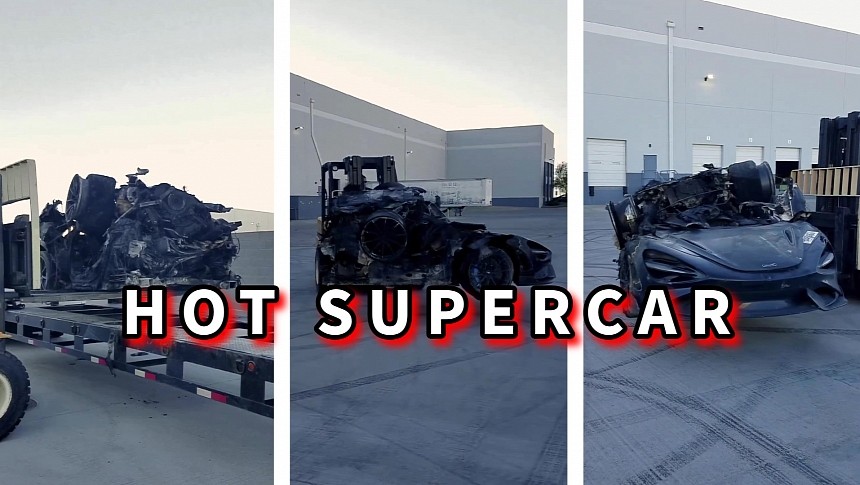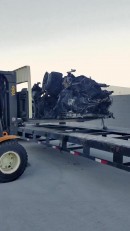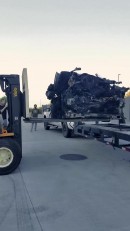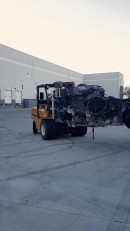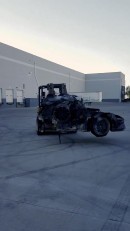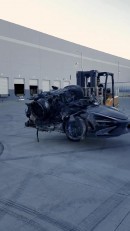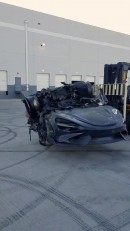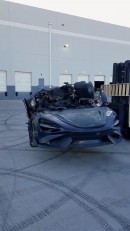Tree huggers might argue that a burnt supercar is a good supercar and one that's certainly better for the environment. But we're all petrolheads here, and most of us still hate the thought of an all-electric future, so seeing an ultra-crispy exotic that was once fed by dead dinosaurs getting its final forklift ride makes us sad.
You are likely curious to find out how this rare and once beautiful McLaren 765LT got destroyed. We are too, yet azcycleparts on Instagram, which shared the clip that we embedded at the bottom of this story on social media recently, did not say anything about it.
Nonetheless, it is obvious that fire got the best of it. The entire car, bar the face, was completely crushed, so it may have been involved in a horrific accident at one point. Either that or it was compacted for easier transportation. Hopefully, the driver is already enjoying another supercar in this world.
Other than the front hood and bumper, and at least one wheel, we don't see what else they can salvage from this 765LT, which is in such a horrible shape that we cannot tell if it started life as a Coupe or Spider. Thus, it's probably going to be recycled. Guess it's a good day to own a 765LT, regardless of the body style, as its value has just increased.
We will remind you that only 765 units of the McLaren 765LT were ever made. The numbers in its name also stand for the output in metric horses, which translates to 755 bhp and 563 kilowatts. The bi-turbo 4.0-liter V8 engine produces 590 pound-feet (800 Nm) of torque and works in concert with a seven-speed gearbox directing the power to the rear axle.
With a curb weight of almost 3,000 pounds (~1,340 kg), the McLaren 765LT Coupe has a top speed of 205 mph (330 kph), down seven mph (11 kph) from the 720S on which it was built. As for the zero to sixty-two mph (0 to 100 kph) acceleration, it can do it in 2.8 seconds, one-tenth quicker than its more mainstream sibling and identical to the new 750S, which taps out at 206 mph (332 kph).
Unveiled half a year ago, the 750S is the company's punchiest series production supercar ever made, and their lightest. It is an evolution of the 720S that it retired, a comprehensive mid-cycle refresh with a different name, which still packs a bi-turbo V8 behind the seats. It produces 740 hp (750 ps/552 kW) and 590 lb-ft (800 Nm), up 30 hp (30 ps/22 kW) and 22 lb-ft (30 Nm) of torque from its predecessor. Pricing starts at $324,000 for the Coupe and $345,000 for the Spider in the United States, and it excludes the $5,500 transportation and port processing charges.
Nonetheless, it is obvious that fire got the best of it. The entire car, bar the face, was completely crushed, so it may have been involved in a horrific accident at one point. Either that or it was compacted for easier transportation. Hopefully, the driver is already enjoying another supercar in this world.
Other than the front hood and bumper, and at least one wheel, we don't see what else they can salvage from this 765LT, which is in such a horrible shape that we cannot tell if it started life as a Coupe or Spider. Thus, it's probably going to be recycled. Guess it's a good day to own a 765LT, regardless of the body style, as its value has just increased.
With a curb weight of almost 3,000 pounds (~1,340 kg), the McLaren 765LT Coupe has a top speed of 205 mph (330 kph), down seven mph (11 kph) from the 720S on which it was built. As for the zero to sixty-two mph (0 to 100 kph) acceleration, it can do it in 2.8 seconds, one-tenth quicker than its more mainstream sibling and identical to the new 750S, which taps out at 206 mph (332 kph).
Unveiled half a year ago, the 750S is the company's punchiest series production supercar ever made, and their lightest. It is an evolution of the 720S that it retired, a comprehensive mid-cycle refresh with a different name, which still packs a bi-turbo V8 behind the seats. It produces 740 hp (750 ps/552 kW) and 590 lb-ft (800 Nm), up 30 hp (30 ps/22 kW) and 22 lb-ft (30 Nm) of torque from its predecessor. Pricing starts at $324,000 for the Coupe and $345,000 for the Spider in the United States, and it excludes the $5,500 transportation and port processing charges.
